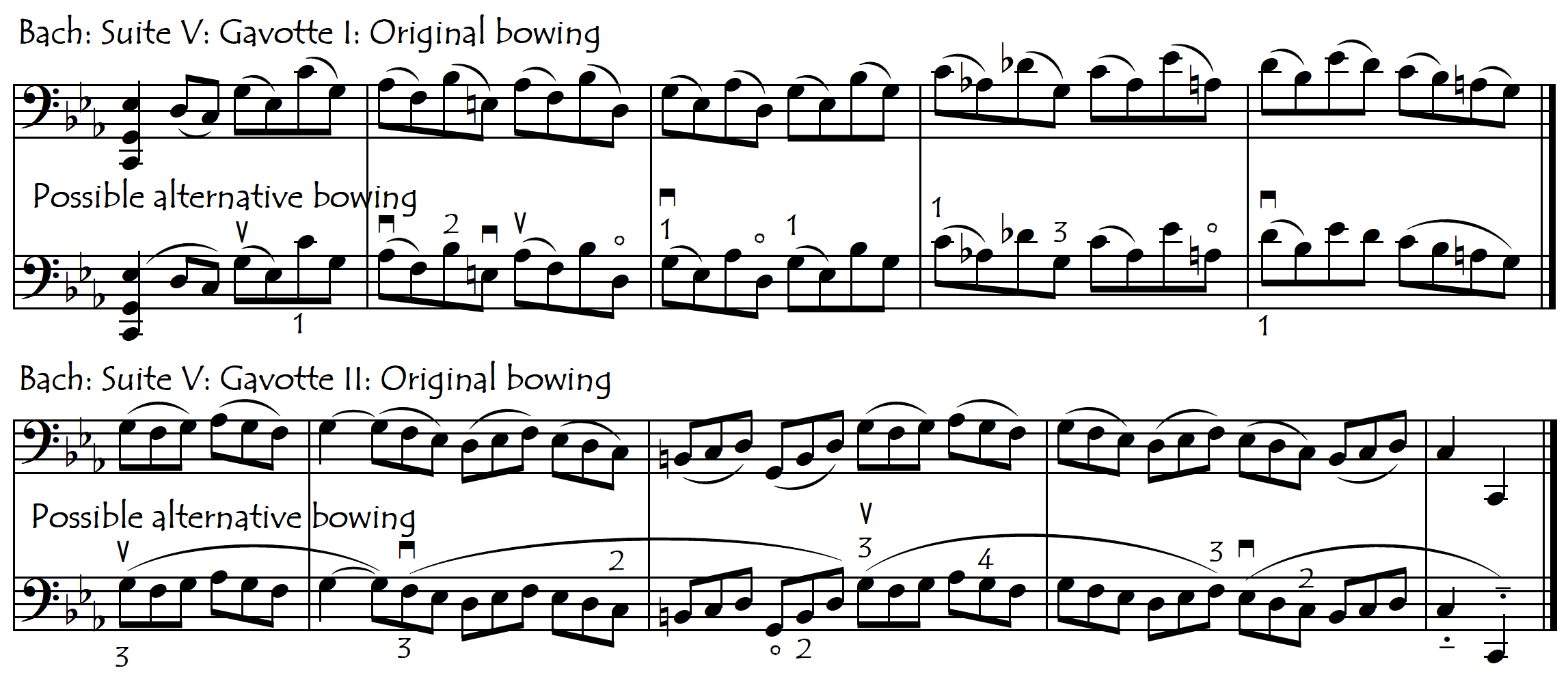Bach: Cello Suite Nº 5 BWV 1011: Sheet Music
For a discussion of the peculiarities of this Bach Cello Suite as well as about the relative advantages and disadvantages of the scordatura and non-scordatura versions, click on the following link:
Bach Suite Nº 5: Scordatura Or Not ? (And Other Peculiarities)
At the bottom of this page is a compilation of the obligatory note modifications that are required for the non-scordatura version.
For each movement of this suite, at least seven different versions will be available for download:
- a comparison of the four different manuscript sources (but here written out at true pitch)
- Bach’s original scordatura notation (as reproduced by the various copyists)
- a Duo Version, in which a “walking bass” accompaniment for a second cello is added to the “solo” part
- Performance Versions, both Edited and Clean, with and without the scordatura tuning
MANUSCRIPT COMPARISONS
Three of the four copies that serve as our most authentic sources use the scordatura notation while the other one uses an “at true pitch” notation but indicates that the suite is also to be played with the A-string tuned down to G. To make the reading easier, all four versions are offered here with an “at true pitch” notation. The purpose of these comparisons is principally to be able to easily compare the differences in slurring and articulation between the four copies. The original scordatura pitch notation for each movement does not differ significantly between the four manuscripts and is included with the performance sheet music versions for each movement.
PERFORMANCE VERSIONS
Both scordatura and non-scordatura versions are presented here together.
PRELUDE AND FUGUE
- Non-Scordatura: EDITED
- Non-Scordatura: CLEAN
- With Scordatura: EDITED
- With Scordatura: CLEAN
- With Scordatura: ORIGINAL NOTATION
ALLEMANDE
In making our playing versions of this movement there are a few significant and difficult decisions that need to be taken concerning the bowings and the dotted rhythms. Do we “double-dot” (see Dotted Rhythms and Rhythmic Factors in Bach) or do we play the more sedate original version (as notated by Bach)? If we do double-dot, then which figures do we modify and which do we leave alone?
- Non-Scordatura: EDITED
- Non-Scordatura: CLEAN
- With Scordatura: EDITED
- With Scordatura: CLEAN
- With Scordatura: ORIGINAL NOTATION
COURANTE
- Non-Scordatura: EDITED
- Non-Scordatura: CLEAN
- With Scordatura: EDITED
- With Scordatura: CLEAN
- With Scordatura: ORIGINAL NOTATION
SARABANDE and GAVOTTES
These movements are published together for page layout reasons.
Curiously, this Sarabande, unlike many others, actually leans onto the third beat of many bars rather than onto the second. In the cellofun performance editions, both the scordatura and non-scordatura versions use identical fingerings, with no use of the A-string. That this was undoubtedly not Bach’s intention can be seen by the notation (scordatura) used by the copyists of the source manuscripts. A more “authentic” interpretation would definitely use the A-string but with the modern cello and modern fingerings, the darkness and gentleness of this timeless, magical movement can perhaps be better achieved by staying on the D-string.
In the Edited Versions of Gavotte I, Bach’s frequent use of consecutive two-slurred 8th-note figures has often been substituted for two slurred followed by two separate notes (or four slurred 8th notes) to give a little more interest/variety to the articulations. For the same reason, the constant slurring of three-note groups in the second Gavotte has not been observed in the cellofun Edited Version (see Bach and the Sewing Machine).

- Non-Scordatura: EDITED
- Non-Scordatura: CLEAN
- With Scordatura: EDITED
- With Scordatura: CLEAN
- With Scordatura: ORIGINAL NOTATION
GIGUE
In this movement, like the Allemande, we have to decide if we want to do “double-dotting” or not. This Gigue’s 43 bars of classic 3/8 dotted rhythm can be even more “frenchified” and lightened by shortening the dotted note slightly as shown in the following example.
But we can make this movement even more dotted, sparkling and “French” by also making the following double-dotting conversion, in which the three semiquavers that lead into the next bars are converted into semidemiquavers. This rhythmic figure occurs twenty times in the movement. 
Not doing this makes the movement more plodding and heavy. It is these modified “double-dotted” rhythms that are found in the playing editions offered here.
- Non-Scordatura: EDITED
- Non-Scordatura: CLEAN
- With Scordatura: EDITED
- With Scordatura: CLEAN
- With Scordatura: ORIGINAL NOTATION
CELLO DUO VERSIONS
Finding a nice second-cello voice for the minor-key suites (V and II) is considerably more complex than for the major-key suites. Here then is my best effort for this suite. It is most certainly very improbable.

